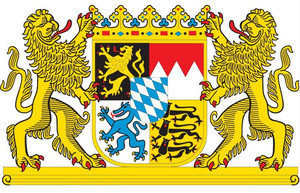Coat of Arms
The Bavarian state coat of arms was introduced on 5 June 1950 together with the "Law on the coat of arms of the Free State of Bavaria". The individual heraldic elements of the "large Bavarian state coat of arms" bear historical meaning.
The golden lion
in the black quarter was originally the symbol of the Palatines of the Rhine. After Ludwig, Duke of Bavaria had been enfeoffed with the Palatinate in 1214, it served as the common symbol of the old Bavarian and Palatine House of Wittelsbach for centuries. Today, the golden Palatinate lion edged in red and rampant in the top left square stands for the Upper Palatinate administrative district.
The "Franconian rake"
The second quarter is halved by red and white (silver) areas, with three white triangles pointing upwards. This "rake" appeared around 1350 as the coat of arms of some towns of the Bishopric of Würzburg and has also been depicted in the seals of the prince-bishops since 1410. Today, the Franconian rake stands for the administrative districts of Upper Franconia, Middle Franconia and Lower Franconia.
The blue panther
The third quarter, bottom left, shows a blue panther rampant, edged in gold on a white (silver) background. Originally it was depicted in the coat of arms of the Palatines of Ortenburg based in Lower Bavaria. Later it was adopted by the House of Wittelsbach. Today, the blue panther represents the old Bavarian administrative districts of Lower Bavaria and Upper Bavaria.
The three black lions
The fourth quarter depicts three black lions couchant, edged in red one above the other, on a gold background. Their heads are turned towards the observer. They are taken from the old coat of arms of the Hohenstaufen dynasty, former dukes of Swabia. In the Bavarian state coat of arms, these three lions represent the administrative district of Swabia.
The white and blue central shield
features white (silver) and blue rhombuses slanting to the right. Formerly the coat of arms of the Counts of Bogen, it was adopted as the coat of arms of the House of Wittelsbach in 1242. The white and blue rhombuses are today regarded as a symbol of Bavaria and are also officially used as the "small Bavarian state coat of arms".
The people's crown
on the four-squared shield with the central shield consists of a golden rim decorated with stones and beset with five ornamental leaves. The people's crown, which first appeared in the coat of arms of 1923, symbolises the sovereignty of the people after the abolition of the royal crown.
Further Links
For further questions regarding the Bavarian state coat of arms please contact the State Ministry of the Interior

